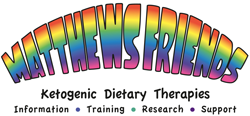Modified Ketogenic Diets (MKD)
Modified ketogenic diets follow similar principles to the traditional classical and medium chain triglyceride (MCT) ketogenic regimes in that they are very low in carbohydrate and high in fat. Therefore, they have a similar effect in altering the balance of fuels available for energy production in the body; moving the body away from using (mainly) glucose for energy to using (mainly) fat for energy
The Modified Atkins Diet (MAD)
In 2003 the team at Johns Hopkins Hospital, Baltimore, USA, discovered that a modified version of the popular Atkins weight loss regime could produce nutritional ketosis and influence seizure symptoms. Since then, around 30 studies, following approximately 400 children and adults, have indicated that the MAD can deliver similar outcomes to the traditional regimes but tends to be easier to follow and is readily tolerated better(1,2).
Following are key aspects of the original USA MAD protocol:
- Carbohydrate intake is initially restricted to 10g per day for children and 20g per day for adults. Note this relates to available or net carbohydrate and EXCLUDES FIBRE.
- Fatty foods are encouraged and should be eaten at each meal / snack
- Protein is allowed freely
- No calorie restriction initially ( this is adjusted according to any weight changes)
- Vitamin and Mineral supplements are necessary
The Low Glycaemic Index Treatment (LGIT)
In 2002, the team at Massachusetts General Hospital, Boston USA started using a novel modified regime that shifted the emphasis towards glucose control rather than simply targeting ketosis (3). It is known that the ketogenic diet readily leads to flat and stable blood glucose levels and that a spike in the blood glucose (due to extra carbohydrate consumption) can trigger a significant increase in seizure activity. Hence the LGIT combines what is known about the varying speeds of glucose absorption from foods (the glycaemic effect of foods and the Glycaemic Index; GI) with a level of carbohydrate restriction that still requires the body to burn fat as its main energy source. Studies in children (3, 4) and young adults (4) indicate a similar level of effectiveness but improved compliance in comparison with traditional ketogenic regimes.
Following are key aspects of the LGIT protocol:
- Carbohydrate intake is restricted to 40-60g and evenly distributed throughout the day.
Note: this figure is total carbohydrate and INCLUDES FIBRE.
- Carbohydrate choices are restricted to foods with a GI Index less than 50.
Note: Most lists in books define Low GI as less than 55
- Fatty foods are encouraged and should be eaten at each meal / snack
- Normal amounts of protein can be eaten
- No calorie restriction initially ( this is adjusted according to any weight changes)
- Vitamin and Mineral supplements are necessary
Who are modified ketogenic diets suitable for?
The advantage of modified regimes is the flexibility of meal choice due to the main focus being around carbohydrate counting, alongside portion guidance to ensure adequate calories from fats. Therefore, they can be a really good option for older children, teenagers and adults who are consistent eaters and willing to count and monitor carbohydrate and fat intake through the day.
Who may require a more traditional ketogenic approach?
A more structured or ‘hybrid’ traditional /modified approach may work better in institutional or care home settings, where many staff may be involved in food choice, preparation and feeding.
Ketogenic tube feeds also tend to be based on a classical ketogenic regime so if there are any additional oral meals or snacks required alongside, these tend to be based around classical principles too.
Modified ketogenic diet prescriptions in the UK;
- Most UK ketogenic teams use modified regimes based on the USA MAD but the initial level of carbohydrate restriction may be higher and vary from one centre to another. Some teams also specify guideline amounts of fat to ensure that weight is maintained, gained or lost in accordance with the needs of the individual.
- Ketogenic diets tend to be based on low carbohydrate foods that also happen to fall into the ‘Low GI’ category (eg. non starchy vegetables, nuts, berry fruits and double cream). This is because they offer larger portions of food per gram of carbohydrate they provide; delivering much better value in meals compared to tiny portions of high carbohydrate, high GI options such as potato.
- Carbohydrate prescriptions relate to the ‘available’ or ‘net’ carbohydrate in foods and exclude fibre. (Carbohydrate data on food labels in the UK and Europe excludes fibre).
- Modified diets generally require vitamin and mineral supplementation, based on individual requirements.
- Some teams may incorporate MCT supplements (MCT oil or emulsion) as a ‘fine tuning’ aid to enhance the effectiveness of modified diets.
Summary
The MAD and LGIT regimes have much in common, but take a slightly different approach to carbohydrate choices. They are both less restrictive and therefore simpler to implement than the traditional ketogenic regimes and can make eating out much easier. However, all ketogenic therapy, whether traditional or modified in its approach requires the same level of medical screening, preparation, monitoring and individual ‘fine-tuning’ from a ketogenic team (normally a neurologist and an experienced registered dietitian).
References:
- Sharma S, Sankhyan N, Gulati S, Agarwala A. Use of the modified Atkins diet for treatment of refractory childhood epilepsy: a randomized controlled trial. Epilepsia 2013 54(3):481-486.
- Kossoff EH, Cervenka MC, Henry BJ, Haney CA, Turner Z. A decade of the modified Atkins diet (2003–2013): Results, insights, and future directions. Epilepsy & Behavior 2013 9:437–442
- Pfeifer HH & Thiele EA. Low-glycemic index treatment: A liberalized ketogenic diet for treatment of intractable epilepsy. Neurology 2005 65:1810-1812.
- Muzykewicz DA, Lyczkowski DA, Memon N, Conant KD, Pfeifer HH, Thiele EA. Efficacy, safety and tolerability of the low glycemic index treatment in pediatric epilepsy. Epilepsia 2009 50(5):1118-1126




